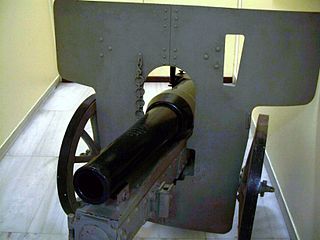
Mountain guns are artillery pieces designed for mountain warfare and other areas where wheeled transport is not possible. They are generally capable of being taken apart to make smaller loads for transport by horses, humans, mules, tractors, or trucks. As such, they are sometimes called "pack guns" or "pack howitzers". During the American Civil War these small portable guns were widely used and were called "mountain howitzers".

Airborne guns are airborne artillery pieces, designed for use by paratroopers. They are generally specific or specialised types of infantry support guns, being in the traditional sense capable of being broken down into smaller loads for transport by aircraft and soldiers, thus also suitable as mountain guns. The historical concept of the "airborne guns" is to some degree outdated, their role being filled by mortars, wire-guided missiles, and/or light anti-tank weapons. As it has been many decades since two industrialized great powers engaged directly in warfare, the concept of the "airborne gun" allowing paratroopers to maintain an airhead against an armored force is in that sense non-functional, but currently, all three of the U.S. Army's howitzers, are air-mobile.

The Ordnance QF 25-pounder, or more simply 25-pounder or 25-pdr, with a calibre of 3.45 inches (87.6 mm), was a piece of field artillery used by British and Commonwealth forces in the Second World War. It was often described as being durable, easy to operate and versatile. It was the major British field gun and howitzer during the War.
OTO Melara was a subsidiary of the Italian company Finmeccanica, today Leonardo, active in the defence sector, with factories in Brescia and La Spezia. The Mod 56 pack howitzer, in service throughout the world, and the 76mm naval gun, adopted by 53 navies and installed on over 1,000 naval vessels, are among OTO Melara's best known weapons since World War II.

The M40 recoilless rifle is a portable, crew-served 105 mm recoilless rifle made in the United States. Intended primarily as an anti-tank weapon, it could also be employed in an antipersonnel role with the use of an antipersonnel-tracer flechette round. The bore was commonly described as being 106 mm caliber but is in fact 105 mm; the 106 mm designation was intended to prevent confusion with incompatible 105 mm ammunition from the failed M27. The air-cooled, breech-loaded, single-shot rifle fired fixed ammunition and was used primarily from a wheeled ground mount. It was designed for direct firing only, and sighting equipment for this purpose was furnished with each weapon, including an affixed spotting rifle.

The L118 light gun is a 105 mm towed howitzer. It was originally designed and produced in the United Kingdom for the British Army in the 1970s. It has since been widely exported. The L119 and the United States Army's M119 are variants that use a different type of ammunition.

The M101A1 howitzer is an artillery piece developed and used by the United States. It was the standard U.S. light field howitzer in World War II and saw action in both the European and Pacific theaters and during the Korean War. Entering production in 1941, it quickly gained a reputation for accuracy and a powerful punch. The M101A1 fires 105 mm high explosive (HE) semi-fixed ammunition and has a range of 12,330 yards (11,270 m), making it suitable for supporting infantry.
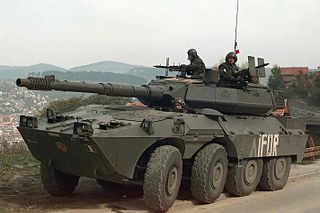
The Centauro is a family of Italian military vehicles originating from a wheeled tank destroyer for light to medium territorial defense and tactical reconnaissance. It was developed by a consortium of manufacturers, the Società Consortile Iveco Fiat - OTO Melara (CIO). Iveco Fiat was tasked with developing the hull and propulsion systems while Oto Melara was responsible for developing the turrets and weapon systems.
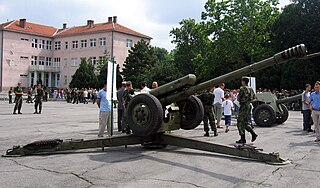
The 122-mm howitzer D-30 is a Soviet howitzer that first entered service in 1960. It is a robust piece that focuses on the essential features of a towed field gun suitable for all conditions. The D-30 has a maximum range of 15.4 kilometers, or over 21 km using rocket-assisted projectile ammunition.

The 105 mm Howitzer M3 was a U.S. light howitzer designed for use by airborne troops. The gun utilized the barrel of the 105 mm Howitzer M2, shortened and fitted to a slightly modified split trail carriage of the 75 mm pack howitzer.
3rd Regiment Royal Horse Artillery is a regiment of the Royal Horse Artillery in the British Army. They are currently based at Albemarle Barracks, Northumberland, England.

The 3rd Field Artillery Regiment (Mountain) (Italian: 3° Reggimento Artiglieria Terrestre (montagna)) is a field artillery regiment of the Italian Army, specializing in mountain warfare. The regiment is based in Remanzacco in Friuli-Venezia Giulia and assigned to the Alpine Brigade "Julia". The regiment was formed in 1909 by the Royal Italian Army as 2nd Mountain Artillery Regiment. In World War I the regiment's groups and batteries served on the Italian front.

The KS-19 100mm anti-aircraft gun is a Soviet anti-aircraft gun that also features good capabilities against ground targets.

The M-56 Howitzer is a 105mm artillery gun from Serbia and Bosnia and Herzegovina. Early towed version is comparable to the German 10.5 cm leFH 18 and the American M101 howitzer while newer M-56A1 and self propelled M-09 Soko has more improvements and greater range.
105 mm is a common NATO-standard artillery and tank gun calibre. The rifled tank round is defined by STANAG 4458. The artillery round is defined by AOP-29 part 3 with reference to STANAG 4425.
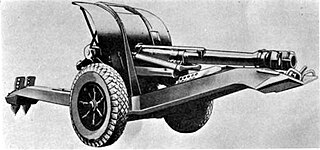
The Obusier de 105 modèle 1950 was a French Howitzer designed and built after World War II for the French Army.
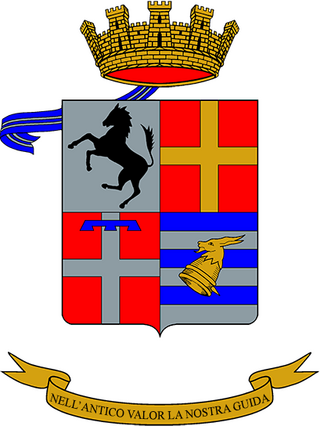
The 24th Field Artillery Regiment "Peloritani" is a field artillery regiment of the Italian Army. Today the regiment is based in Messina in Sicily and assigned to the Mechanized Brigade "Aosta". Originally an artillery regiment of the Royal Italian Army, the regiment was formed in 1888 and served in World War I on the Italian front. In 1935 the regiment was assigned to the 29th Infantry Division "Peloritana", which fought in the Second Italo-Ethiopian War. In 1939 the division was renamed as the 29th Infantry Division "Piemonte". The division participated in the Greco-Italian War and then remained in Yugoslavia on anti-partisan duty. The division and regiment were located on the Peloponnese peninsula, when the Armistice of Cassibile was announced on 8 September 1943. The division and its units surrendered to attacking German forces on 11 September.

















